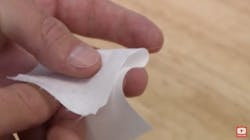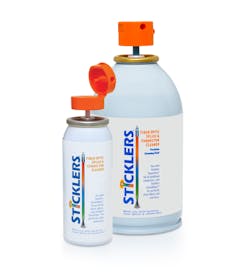Skilled cleaning leads to first-rate fiber splices
By Jay Tourigny, MicroCare Corp.
Tio ensure a robust and long-term reliable fiber-optic network, it is important that the fiber is cleaned during fusion splicing. Contamination is the primary cause of network disruption or failure. Splices must be properly cleaned or the splice could be optically defective or mechanically weak. Dirty fiber splices can cause network problems including back reflection, signal loss and even fiber breakage at the splice, causing complete network failure.
There is a right way to clean fusion splices. Because high heat is generated by arcing electrodes during the fusion splicing process, technicians should always follow the recommended processes supplied with the fusion splicing equipment. This ensures safety for the operator and equipment, and perfectly cleaned fiber for reliable splicing every time.
IPC-8497-1 is the international standard for cleaning fiber-optic splices. IPC (Institute of Printed Circuits) and iNEMI (international Electronics Manufacturing Initiative) and other fiber industry organizations recommend cleaning with the wet/dry method because it cleans fibers to meet that cleanliness standard. Plus, wet/dry cleaning helps dissipate static and eliminates any triboelectric charge that could damage the network.
How to wet/dry clean
Wiping a fiber splice with a dry wipe goes only halfway in terms of cleaning, and it generates a significant static charge, which in turn attracts dust that is extremely difficult to dissipate. Wet/dry cleaning with the right cleaning fluid increases both the surface cleaning performance and the humidity on fiber to dissipate the surface static. During the wet/dry cleaning process, you use a section of an optic-grade cleaning wipe, dampened with a static dissipative cleaning fluid. You wipe the splice starting at the damp area and move in one direction towards the dry area of the cleaning wipe. This removes the contamination and minimizes the static charge in one step.
Prepare for cleaning
First, be sure your hands are clean. Clean hands are less likely to transfer dirt and oils that can compromise the cleaning process. However, don’t apply a moisturizer or lotion to your hands prior to cleaning the fiber. This attracts more contaminants and causes oils to transfer onto the cleaning wipe, and everything else you touch, including the cable you are trying to clean.
Don’t wear gloves when working on fiber. While you may think that wearing gloves will protect the cleaning materials from the oils in your skin, you will actually be adding more particulate compared to clean hands. Gloves are a carrier of all kinds of microscopic particles and oils. It’s best to simply wash your hands prior to cleaning the fiber splice.
Then strip the protective polymer coating around the optical fiber using a appropriate hand stripper or thermal stripper. You should refer to your fusion splicer user instructions for specific details on how much of the polymer jacket to remove from each end.
Clean exposed fibers with the right fluid
Once the polymer coating has been stripped from the fiber, it needs to be cleaned. Cleaning the stripped fiber removes any remaining debris from the stripping process, plus any other contaminants that may be on the exposed fiber.
Clean the exposed fiber(s) by folding a lint-free wipe in half and then moisten the wipe with a fiber-optic cleaning fluid. Many operators use alcohol as their preferred cleaning fluid. However, with the recent Covid-19 pandemic, alcohol is in short supply and it may be months before isopropyl alcohol (IPA) becomes readily available again. In addition the price of IPA has quadrupled, fueled by the increased demand and short supply. The days of relatively inexpensive IPA pricing will likely not come back for years. Fortunately, there are other options. (See sidebar.)
A better alternative
There are better alternatives to alcohol for fiber sidewall cleaning prior to splicing. Many of them clean just as well, if not better than alcohol. Operators should look for a high-purity cleaning fluid that cleans the fiber without leaving residue behind. Additionally, IPA alternatives specifically engineered for cleaning fiber typically evaporate much faster than IPA, so it saves on cleaning time.
For safety out in the field, choose a cleaning fluid that’s nonflammable. Also, use a fluid that is in a hermetically sealed container. A sealed container ensures the cleaning fluid is never contaminated. It also won’t spill if it tips over in a toolkit or while in use. If you pre-ship fluids and tools to job sites, choose a fiber cleaning fluid that ships non-hazardous and non-regulated. This saves on shipping costs. In some instances, these cleaning fluids also come in travel-sized containers. So, you’ll still meet the TSA 3-ounce or less rule if you take it with you in your carry-on bag when flying to a work site.
Too much of a good thing
When wetting the cleaning wipe with cleaning fluid, do not oversaturate the wipe. Putting too much cleaning fluid on the fiber increases the chance that the fiber ends will be re-contaminated as the fluid absorbs dust, exhaust fumes and other impurities from the air. Choose a cleaning fluid in a package that delivers the cleaning fluid in metered doses. This controls the amount of cleaning fluid on the fiber and ensures the surfaces are dry after cleaning. It also limits operator exposure and cleaning fluid waste.
Wipes are an essential tool for successful splice cleaning. For the best results, opt for an optical-grade fabric wipe engineered for cleaning fiber. Fabric wipes are highly absorbent to effectively wick the contamination away from the splice while not generating lint.
Remember to use just one wipe per splice. It is commendable that you want to save your company money by reusing wipes to control costs or to protect the environment. However, by reusing wipes, you run the risk of cross-contaminating the network resulting in more time on the job or a costly callback. Used wipes will most likely redeposit particulate or oils back onto the splice.
The next steps
After wetting the wipe, fold the moistened wipe around the fiber strand(s) and gently pinch and pull the fiber through the folded wipe 1 to 2 times or until you hear the fiber “squeak,” indicating it is clean. The cleaning fluid completely evaporates in seconds, leaving the fiber clean and dry.
If you are splicing ribbon fiber, gently flair the fiber strands with your index finger to ensure they are dry and don’t cross. Using a precision fiber cleaver and appropriate fixtures, cleave the fiber(s) so the end(s) are perpendicular and smooth across the axis. The cleaved end(s) should be kept in the fixtures. Use care to keep the end(s) clean up to the point of splicing and be certain to properly dispose of fiber shards so they don’t become an impossible-to-find splinter in your finger.
There is nothing cleaner than the endface of a newly cleaved fiber, so do not clean again after cleaving. If you do, the fiber ends will become contaminated. This creates extra work for the fusion splicer in the splicer in the pre-burn phase, and may shorten the lifespan of the unit’s electrodes. Contamination also will degrade the mechanical strength of the splice in the form of non-linear splices with imperfections, and ultimately cause excess signal losses.
The fiber(s) now are ready to join together by placing the fixtures with the clean, cleaved fiber into the fusion splicer’s “V” groove fixtures. This process involves the alignment of the two opposing ends of the fiber, and the splicer uses an electric arc across the opposing fiber ends to precisely melt and permanently join the ends.
Best tools and methods
There is no doubt that reliable, trouble-free fiber-optic networks are the key to our interconnected future. But one of the biggest threats to fiber signals today is contamination. Dirty fiber splices can cause network problems including weak signals or a complete network shutdown. Therefore, properly cleaning your fiber splices during installation or maintenance is essential to keeping your network operating reliably.
By using the correct cleaning methods and selecting the best tools, you can help assure your fiber splicing success. When in doubt, seek the help of an experienced supplier that specializes in fiber cleaning supplies to advise you on which tools and methods will work best for you.
Jay Tourigny is senior vice president of MicroCare Corp., which offers Sticklers brand fiber cleaning solutions. He has more than 30 years of industry experience and holds numerous U.S. patents for cleaning-related products that are used daily in fiber-optic, medical, and precision-cleaning applications.
How the IPA shortage affects fiber cleaning practices
For years experts have been telling fiber-optic technicians not to use isopropyl alcohol (IPA) to clean fiber endfaces. Some technicians have listened; some haven’t. Today, one of Covid-19’s many effects on global commerce is the scarcity of IPA. We spoke with Rick Hoffman, MicroCare’s national account manager for Sticklers, about the IPA shortage and its practical impact on fiber cleaning.
Q: Isopropyl alcohol (IPA) is in short supply as the world battles the Covid-19 pandemic. Is the shortage simply a matter of demand overwhelming supply, or do any other factors (such as supply chain) also contribute?
A: The IPA shortage was caused initially by the sudden demand. Overnight, every factory, office, facility and home wanted IPA and IPA-based products to wipe down and disinfect surfaces. This is in addition to the increased need for IPA within the global healthcare sector. This abrupt demand has overwhelmed the entire supply chain, and depending on how long the Covid-19 virus remains a threat, it may be months before IPA becomes readily available.
Q: Do you have insight, or an opinion, on the mid- to long-term outlook for IPA supply?
A: Isopropyl alcohol supplies will continue to be tight in the upcoming months. But as IPA manufacturers ramp up their output, we should see supply open up incrementally. However, the price of IPA has quadrupled, fueled by the increased demand and short supply. The days of relatively inexpensive IPA pricing will likely not come back for years.
Q: IPA is not recommended for cleaning fiber endfaces because of its relative ineffectiveness compared to other tools and fluids. What are some better alternatives to using IPA?
A: There are some really good alternatives to IPA for cleaning fiber optics. Many of them clean just as well, if not better than alcohol. The Sticklers Fiber Optic Splice & Connector Cleaner is one example.
.
Q: Are these and other fiber-cleaning products also in short supply?
A: The Sticklers Fiber Optic Splice & Connector Cleaner is in-stock and ready to ship. Since the cleaning fluid is not IPA-based, it is in plentiful supply and not impacted by the frenzied global demand for IPA.
Q: MicroCare, parent company of the Sticklers brand, serves cleaning needs across many industries. Can you share insight into the challenges that face telecommunications technicians, compared to or contrasted with the challenges that other industries face?
A: Fortunately, most telecommunications teams are outdoors or inside secure rooms where there are minimal numbers of people operating. This is a safer environment than on factory floors, in hospitals, or at other building structures that house many more people. The fewer people in the fiber technician’s area, the less chance of being exposed to the Covid-19 virus. This, of course, doesn’t mean they can be less vigilant about wearing masks and washing their hands as recommended by the CDC (Centers for Disease Control and Prevention). It is also a good idea for technicians to wipe down any work surfaces with a general-purpose cleaning wipe before starting any fiber work. This helps remove any contaminant that might be lurking on the work surface.



